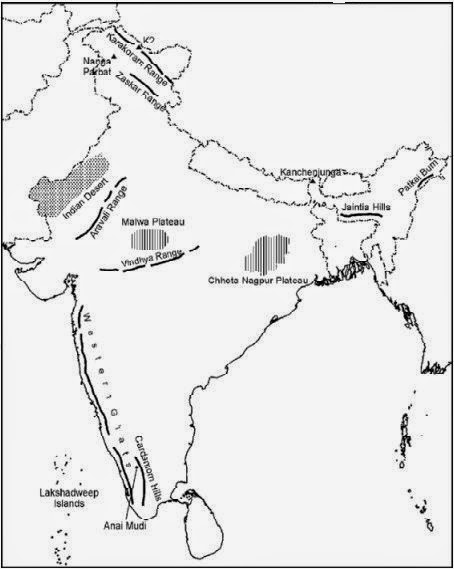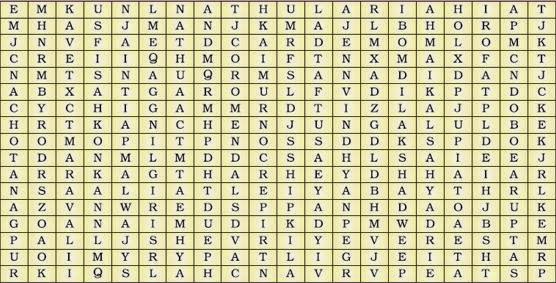GetStudySolution
Getstudysolution is an online educational platform that allows students to access quality educational services and study materials at no cost.
NCERT Solutions for Class 9 Geography chapter 2 – Physical Features of India
Back Exercise
1. Choose the right answer from the four alternatives given below :(i) A landmass bounded by sea on three sides is referred to as
(a) Coast
(ii) Mountain ranges in the eastern part of India forming its boundaries with Myanmar
are collectively called :
(a) Himachal
(iii) The western coastal strip south of Goa is referred to as
(a) Coromandel
(a) Anai Mudi
(i) What is bhabar?
(ii) Name the three major divisions of the Himalayas from north to south.
(iii) Which plateau lies between the Aravali and the Vindhyan ranges?
(iv) Name the island group of India having coral origin.
Answer
(i) The Bhabar is that narrow belt of the plain which is covered with pebbles and lies along the foothills of the Shiwaliks from the Indus to the Tista.
(ii) The Great or the Inner Himalayas or the Himadri, the Middle Himalayas or the Himachal, and the Outer Himalayas or the Shivaliks.
(iii) The Malwa plateau lies between the Aravali and the Vindhya Ranges.
(iv) Lakshadweep Islands is the island group of India having coral origin.
Page No: 16
3. Distinguish between
(i) Converging and Diverging Tectonic Plates.
(ii) Bhangar and Khadar
(iii) Western Ghats and Eastern Ghats
Answer
(i)
Converging Tectonic Plates
|
Diverging Tectonic Plates
|
| When tectonic plates move towards each other, they are called converging plates. | When tectonic plates move away from each other, they are called diverging plates. |
| They collide or crumble or one of them slides under the other while moving towards each other. | They do not collide or crumble while moving away from each other. |
| Converging plates cause folds. | Diverging plates cause fractures in the crust. |
(ii)
Bhangar
|
Khadar
|
| These are the older alluvium or old soil and form the largest part of the Northern Plains. | The newer and younger deposits of the flood plains. Renewed every Year. |
| Presents a terrace like feature. | Contains calcerous deposits locally known as Kankar. |
| Less fertile | More fertile |
(iii)
Western Ghats
|
Eastern Ghats
|
| Mark the western edge of the Deccan Plateau | Mark the eastern edge of the Deccan Plateau |
| Continuous, can be crossed through the passes only. | Discontinuous, irregular and dissected by rivers draining into the Bay of Bengal. |
| Higher; average elevation is 900−1600 meters | Lower; average elevation is 600 meters |
| It experiences orographic rain mostly in summer due to the summer monsoons. The climate is hot and moist. | It receives rain mostly in winter through North-eastern monsoon. However, here the rain is lesser than the western strip. |
| Soil is highly fertile. Rice, spices, rubber and fruits like coconuts, cashew nuts etc. are grown | Soil is not as fertile as western ghats. Rice, ground nuts, cotton, tobacco, coconuts etc. are grown |
4. Describe how the Himalayas were formed.
Answer
According to the Theory of Plate Tectonics, the Earth's crust was initially a single, giant super-continent called Pangea. Gradually, Pangea began to split into a number of pieces due to convectional currents and formed Angaraland and Gondwanaland. Angaraland is the Eurasian land mass and Gondwanaland included India, Australia, S. Africa and S. America as one single land mass. The Indo-Australian plate separated from the Gondwana land due to convectional currents and drifted towards north. Due to this collision, the sedimentary rocks which were accumulated in the geosyncline known as the Tethys were folded to form the mountain system of western Asia and Himalaya.
Answer
The major physiography divisions of India are :
(i) The Himalayan Mountains
(ii) The Northern Plains
(iii) The Peninsular Plateau
(iv) The Indian Desert
(v) The Coastal Plains
(vi) The Islands
The Himalayan Region
|
The Peninsular Plateau
|
| Young fold mountains made from the uplift of the strata formed by the sedimentary rocks. | Ancient landmass created after splitting of Gondwanaland. |
| Consists of the loftiest mountains and deep valleys | Consists of broad and shallow valleys, and rounded hills |
| Composed of sedimentary rocks. | Composed of igneous and metamorphic rocks. |
| It is the origin of perennial rivers. | It has rainfed, seasonal rivers. |
| From the point of view of geology, this region forms an unstable zone | This region forms a stable zone |
6. Give an account of the Northern Plains of India.
Answer
The northern plain has been formed by the interplay of the three major river systems, namely the Indus, the Ganga and the Brahmaputra along with their tributaries. This plain is formed of alluvial soil which is suitable for agriculture. It spreads over an area of 7 lakh sq. km. The plain is a densely populated physiographic division. The Northern Plain is broadly divided into three sections, Punjab Plains, Ganga Plains and Brahpmputra plains. According to the variations in relief features, the Northern plains can be divided into four regions. Bhabar, a narrow belt of pebbles which lie at the foot of Shivaliks. Terai, lie next to Bhabar which a wet and marshy area with wildlife and forests. Bhangar is made up of older alluvium plain which rises above the level of the flood plains. Khadar is a younger alluvium of the flood plains.
7. Write short notes on the following.
(i) The Indian Desert
(ii) The Central Highlands
(iii) The Island groups of India
Answer
(i) The Indian desert lies towards the western margins of the Aravali Hills. It is an undulating sandy plain covered with sand dunes called barchans. This region receives very low rainfall below 150 mm per year. It has arid climate with low vegetation cover. Streams appear during the rainy season. Soon after they disappear into the sand as they do not have enough water to reach the sea. Luni is the only large river in this region.
(ii) The part of the peninsular plateau lying to the north of the Narmada River covering a major area of the Malwa plateau is known as the Central Highlands. The Vindhyan range is bounded by the Central Highlands on the south and the Aravali range on the northwest. The flow of the rivers draining this region, namely the Chambal, the Sind, the Betwa and Ken is from southwest to northeast, thus indicating the slope. The Central Highlands are wider in the west but narrower in the east. The eastward extensions of this plateau are locally known as the Bundelkhand and Baghelkhand. The Chotanagpur plateau marks the further eastward extension, drained by the Damodar River.
(iii) India has two main island groups, namely Lakshadweep and Andaman and Nicobar island. The Lakshadweep consists of many small islands located opposite the Kerala coast in the Arabian Sea. The islands of this group are formed of coral deposits. It covers small area of 32 sq km. Kavaratti island is the administrative headquarters of Lakshadweep. The Andaman and Nicobar Islands, on the other hand, are larger in size. They are more in number and more widely scattered. These islands are an elevated portion of submarine mountains.
Map Skills
On an outline map of India show the following.
(i)Mountain and hill ranges – the Karakoram, the Zaskar, the Patkai Bum, the Jaintia, the Vindhya range, the Aravali, and the Cardamom hills.
(ii) Peaks – K2, Kanchenjunga, Nanga Parbat and the Anai Mudi.
(iii) Plateaus, Chotanagpur and Malwa
(iv) The Indian Desert, Western Ghats, Lakshadweep Islands
Answer



CHOTANAGPUR
ARAVALI
KONKAN
JAINTIA
MALWA
NILGIRI
SHIPKILA
VINDHYA
BOMDILA
SAHYADRI
SATPURA
Horizontal
NATHULA
CARDEMOM
GARO
KANCHENJUNGA
ANAIMUDI
EVEREST
PATLI
In-Text Questions
On Page 11
Question 1. Find out the names of the glaciers and passes that lie in the Great Himalayas.
Answer
The names of the glaciers that lie in Great Himalayas are
(a) Siachen Glacier – Jammu and Kashmir
(b) Godwin Glacier – Jammu and Kashmir
(c) Gangotri Glacier – Uttarakhand
(d) Yamunotri Glacier – Uttarakhand
Passes that lie in the Great Himalayas
Himachal Pradesh Rohtang Pass, Karakoram Pass, Rupin Pass
Sikkim Nathu La, Jelep La
Uttarakhand Mohan Pass
Question 2. Find out the name of the states where highest peaks are located.
Answer States where highest peaks are located are
(a) Jammu and Kashmir (Nanga Parbat)
(b) Sikkim (Kanchenjunga)
(c) Uttarakhand (Nanda Devi, Kamet)
Question 3. Find out the location of Mussoorie, Nainital, Ranikhet from your atlas and also name the state where they are located.
Answer All the three towns are in the state of Uttarakhand in the range called lesser Himalaya or Himachal.